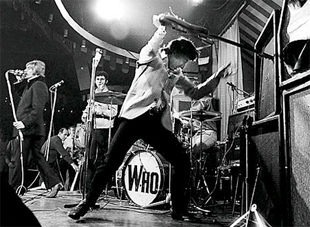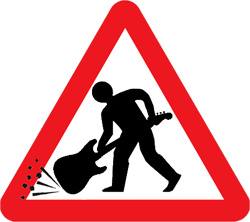![]() I could almost hear the gentle shuffle of feet and slow intake of breath while courage was gathered. A long pause. Then the news. A fellow audio journalist and good friend has been told that he needs hearing aids. It's a confession...
I could almost hear the gentle shuffle of feet and slow intake of breath while courage was gathered. A long pause. Then the news. A fellow audio journalist and good friend has been told that he needs hearing aids. It's a confession...
Another silence. It is an awkward moment at both ends of the phone. Although we are the press, we do audio. We love audio. The unspoken question, then – is it all over for him?
Given the tone of the conversation, we will not be naming names here – although some of you will know who he is. Like him and a good number of other pro audio hacks, I played in bands and went to countless gigs before becoming a journalist. And I’ve done more of both since.
Before any kind of regulation appeared or sense dawned, it was easy to subject yourself to painful sound levels. It went with the territory, and my hearing has also suffered as a result – thankfully, less badly.
Our friend here counts the Guinness Book of Records loudest ever concert among his encounters with high SPLs – The Who at Charlton Athletic Football Club in 1976. This is on record as delivering 126dB 32m from the PA – about where he was standing. At 100m, jet engines deliver 110dB-140dB; Big Ben rings in at 118dB. Long-term exposure to levels above 85dB will cause hearing damage.
Times change. Now there’s a girl in America whose mother is fixing to sue Justin Bieber because his fans are just too damn loud for her.
The Roaring Silence
 There has been plenty of talk – and some action – regarding hearing loss and damage in pro audio. Health and safety legislation, a growing awareness of the risk of permanent hearing damage and the arrival of in-ear monitoring are now playing their part. Unsurprisingly, all of this centres on live sound, particularly mixing engineers and stage crew.
There has been plenty of talk – and some action – regarding hearing loss and damage in pro audio. Health and safety legislation, a growing awareness of the risk of permanent hearing damage and the arrival of in-ear monitoring are now playing their part. Unsurprisingly, all of this centres on live sound, particularly mixing engineers and stage crew.
Live sound is becoming a ‘safer’ place to work then. But for journalists?
‘Journalism isn’t the first career most people would list as carrying a hearing risk,’ my friend pointed out. ‘But at no time during 22 years spent going to (lots of) gigs, interviewing artists, managers, crew and production companies, and – inevitably – being on the receiving end of regular doses of high volume live music did any of my employers highlight the potential dangers of regular exposure to loud music.
‘Common sense applies, of course; I knew what I was dealing with and there was nothing preventing me from buying my own earplugs, but that’s not the point. The point is, they really should highlight those dangers – even if they are patently obvious – and provide appropriate hearing protection for use in the field of work with a firm directive to apply. Would you send a labourer onto a building site without a hard hat?’
Point well made.
‘The diminishing quality of my hearing has been affecting conversation so much lately that I recently booked an ENT appointment,’ my friend explained. ‘The test results revealed that my higher frequency hearing starts to drop off sharply around the 2kHz mark, which was no surprise as I tend to miss the more sibilant tones of everyday chat.’
This recent conversation rekindled another that I had a while ago with the relentless Philip Newell. Veteran studio designer Philip’s earlier career found him in the role of technical director at Virgin’s Manor Studios as well as being a recording engineer. He knows the value of his hearing, and is aware of its failing.
‘Back in the 1960s and ’70s I must have performed line-up procedures on analogue tape recorders many thousands of times,’ he says. ‘These were done with tones at 50Hz or 100Hz, 1kHz, 10kHz and 15kHz. I remember the sounds so clearly, and yet, for many years now, the 15kHz tone has been totally inaudible to me. These days, even the 10kHz tone is somewhat down in level.’
This came up as part of a different discussion – one related to the less scientific judgements passed by the hi-fi industry.
Nothing to lose?
‘I am not ashamed for people to know that I am stone deaf above 11kHz, even though my job is an acoustics consultant,’ he says. ‘If people are going to employ my services as a specialist, they have the right to know such information. And considering my age, my hearing is statistically not bad at all.’
Aside from the personal loss, damaged or degraded hearing in an audio business threatens professional ability and standing. But not in all cases, if Philip Newell is right. ‘Am I likely to lose work when people read this?’ he questions. ‘Probably not, because people trust my experience and know that I will seek help for anything that I am not able to reliably do myself.’
 I’m inclined to think that the same is true of my colleague. He knows his stuff and people know he knows it. But it shouldn’t have come to this…
I’m inclined to think that the same is true of my colleague. He knows his stuff and people know he knows it. But it shouldn’t have come to this…
His challenge needs to be taken seriously by the audio press and publishing companies. There is clearly a real – and genuinely overlooked – duty of care here. Will any publisher be big enough to acknowledge it? Or is there another lawsuit in the making?
For the benefit of Stacey Wilson Betts, the loudest scream by a crowd (indoors) on record is 131.6dB (A weighted). This was achieved by the audience at a 2009 concert at Hong Kong International Trade & Exhibition Centre in Hong Kong given by Hong Kong rappers, Fama. I’m sure the lawyers behind her US$9.23m lawsuit will have logged this before they go up against Justin Bieber’s legal team.
While the Beatles’ Shea Stadium PA system was measured in hundreds of watts, the noise made by 55,000 fans in 1965 has become legendary. But unmeasured. Do we think that Bieber’s 15,000-strong Rose Garden audience delivered a higher SPL? Perhaps it did – but there were no lawsuits over hearing damage. An indication of the increasingly legislative culture of the US.
Bieber and co-defendants are accused of failing to provide safe sound levels – not only from the PA, but also from the crowd. It will be interesting to see how this pans out… and to find out what, if anything, is going through the minds of the employers of audio journos.

